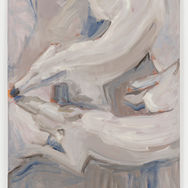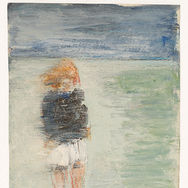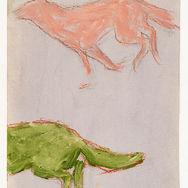MERCEDES LARRETA
Si se escribiera la genealogía artística de Mercedes Larreta, según el modelo de Marco Aurelio en el Libro I de sus Meditaciones, podría empezarse diciendo sobre sus maestros, en estricta cronología: de Eduardo Audivert (1990), se quedó con la magia de la acuarela, la aceptación de la voluntad de la gota y su pigmento; de Guillermo Roux (2005), con el destino blando del óleo; de Norberto Marcet (2009), con la representación de la figura humana y el reflejo para fijar lo pasajero en su condición pasajera; del limeño Eulogio de Jesús (2016), con la libertad que concede la crítica honesta sobre la obra propia.
Mercedes Larreta pertenece a una familia de artistas, y ella misma se reparte desde hace años entre la pintura y la poesía.
La obra de Mercedes Larreta, que no le saca nunca la mirada a los árboles y los ríos, se inicia con la incertidumbre feliz del trazo, de su irrupción inesperada y llega, después una maduración sin vestigios de esfuerzo, a devolvernos el dibujo, ya no como contingencia sino como necesidad. Cerrado sabiamente sobre sí mismo, cada trabajo se nos ofrece a una contemplación de horizonte abierto.

If Mercedes Larreta’s genealogy as an artist were to be written according to the model Marcus Aurelius provides in Book I of his Meditations, it might begin with a strict chronology of her teachers and what she got from each one of them: from Eduardo Audivert (1990), the magic of watercolor and acceptance of the independent will of the drop and its pigment; from Guillermo Roux (2005), the soft fate of oil paint; from Norberto Marcet (2009), representation of the human figure and the reflex to capture the fleeting in its fleetingness; from Lima-native Eulogio de Jesús (2016), the freedom that comes from a honest critique of one’s own work.
Mercedes Larreta comes from a family of artists; she herself has, for years, divided her interest between painting and poetry.
Mercedes Larreta’s art, which never ever looks away from trees and rivers, begins with the joyous uncertainty of the line, with its unlikely outburst to then, pursuant to a maturation process that seems utterly effortless, deliver us back to drawing, no longer as contingency but as necessity. Wisely closed in on itself, each work offers us a chance to contemplate an open horizon.

BIO
Mercedes Larreta, nacida en Buenos Aires, es artista visual y poeta argentina cuya obra, influenciada por vivencias y paisajes, refleja su formación con maestros como Eduardo Audivert, Guillermo Roux y Eulogio de Jesús. Su arte, un diálogo entre pintura y poesía, se caracteriza por la incertidumbre feliz del trazo y una expresión madura que invita a la contemplación abierta. En años recientes, ha trabajado con un equipo de renombre que incluye a Ana Martínez Quijano, Pablo Gianera, Diana Flatto y los diseñadores Marius Riveiro Villar y Carlos Caturini. Larreta ha dedicado su vida a explorar la intersección entre pintura y poesía, dejando un legado que es tanto personal como una contribución al arte contemporáneo.
Mercedes Larreta, born in Buenos Aires, is an Argentine visual artist and poet whose work, influenced by experiences and landscapes, reflects her training with masters such as Eduardo Audivert, Guillermo Roux, and Eulogio de Jesús. Her art, a dialogue between painting and poetry, is characterized by the joyful uncertainty of her strokes and a mature expression that invites open contemplation. In recent years, she has worked with a renowned team including Ana Martínez Quijano, Pablo Gianera, Diana Flatto, and designers Marius Riveiro Villar and Carlos Caturini. Larreta has dedicated her life to exploring the intersection between painting and poetry, leaving a legacy that is both personal and a contribution to contemporary art.


















